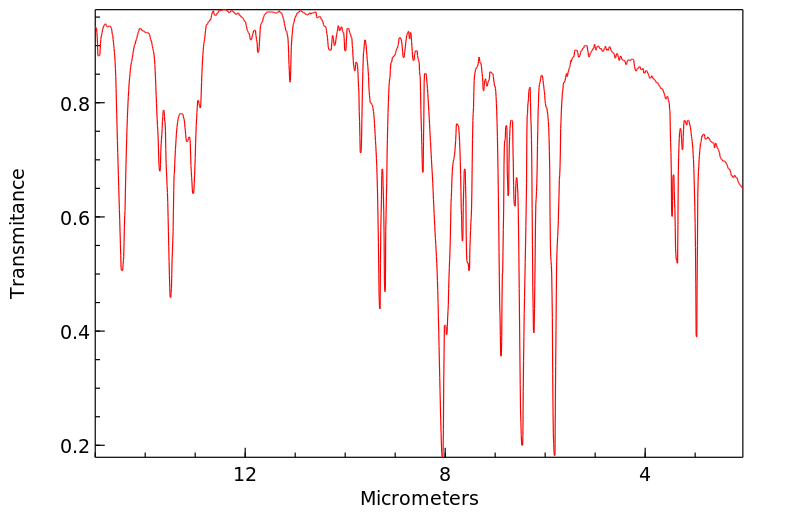N-苯基氨基甲酸戊酯 | 63075-06-9
中文名称
N-苯基氨基甲酸戊酯
中文别名
——
英文名称
pentyl N-phenyl-carbamate
英文别名
phenylcarbamic acid amyl ester;pentyl N-phenylcarbamate;pentyl phenylcarbamate;phenylcarbamic acid pentyl ester;phenyl-carbamic acid pentyl ester;Phenyl-carbamidsaeure-pentylester;N-Pentyl N-phenylcarbamate
CAS
63075-06-9
化学式
C12H17NO2
mdl
MFCD00027271
分子量
207.272
InChiKey
BIYXGLPPMRDUNY-UHFFFAOYSA-N
BEILSTEIN
——
EINECS
——
-
物化性质
-
计算性质
-
ADMET
-
安全信息
-
SDS
-
制备方法与用途
-
上下游信息
-
文献信息
-
表征谱图
-
同类化合物
-
相关功能分类
-
相关结构分类
计算性质
-
辛醇/水分配系数(LogP):3.8
-
重原子数:15
-
可旋转键数:6
-
环数:1.0
-
sp3杂化的碳原子比例:0.416
-
拓扑面积:38.3
-
氢给体数:1
-
氢受体数:2
安全信息
-
海关编码:2924299090
SDS
反应信息
-
作为反应物:描述:参考文献:名称:(4-芳基氨磺酰基)苯基氨基甲酸酯:I.疱疹病毒的合成及活性摘要:为了改变磺酰胺的生物活性,制备了许多烷基(4-芳基氨磺酰基)-苯基氨基甲酸酯,收率为50-70%。生物筛选表明,目标化合物具有抗疱疹病毒的高活性以及传统的抗生素。DOI:10.1134/s1070363216070069
-
作为产物:参考文献:名称:新型的多用途二甲基甲酰胺样离子液体制备离子液体基Vilsmier试剂及其应用摘要:在继续探索类似DMF的离子液体的应用潜力的研究中,已从类似DMF的离子液体合成了N,N-二甲基亚甲基氯化铵(Vilsmier试剂)的离子液体版本,并对其有效容量进行了测试,以实现更多有用的有机物。转变。结果表明,类DMF离子液体是世界上第一个特定任务的离子液体,它催化了多种多样的反应,并在其应用中具有多种用途。因此,已经为这种DMF类离子液体创造了一个新术语,即DMF类“多用途”离子液体。DOI:10.1002/cjoc.201280028
文献信息
-
Direct Catalytic Synthesis of <i>N</i> ‐Arylcarbamates from CO <sub>2</sub> , Anilines and Alcohols作者:Masazumi Tamura、Ayaka Miura、Masayoshi Honda、Yu Gu、Yoshinao Nakagawa、Keiichi TomishigeDOI:10.1002/cctc.201801443日期:2018.11.7The direct catalytic synthesis of carbamates from CO2, amines and methanol was achieved by controlling both the reaction equilibrium and the reactivity of the three components. The combination of CeO2 and 2‐cyanopyridine was an effective catalyst, providing various carbamates including N‐arylcarbamates in high selectivities.
-
PRODUCTION METHOD OF CARBAMIC ACID ESTER申请人:NATIONAL INSTITUTE OF ADVANCED INDUSTRIAL SCIENCE AND TECHNOLOGY公开号:US20190185420A1公开(公告)日:2019-06-20A method of production of carbamic acid ester has a high yield and high selectivity and is superior in economy. The method of production of a carbamic acid ester includes reacting an amine, carbon dioxide, and an alkoxysilane compound in the presence of a catalyst containing a zinc compound or an alkali metal compound or in the presence of an ionic liquid. A carbamic acid ester is produced, for example by reacting aniline, carbon dioxide, and tetramethoxysilane at a temperature of 150 to 180° C. in the presence of zinc acetate and 2,2′-bipyridine.
-
Effect of successive increase in alcohol chains on reaction with isocyanates and isothiocyanates作者:Shahnaz Perveen、Arfa Yasmin、Khalid Mohammed KhanDOI:10.1080/14786410802270738日期:2010.1.10The reaction of isocyanates and isothiocyanates with long-chain alcohols, e.g. n-hexanol, n-heptanol and n-octanol, exclusively gave N-aryl-O-alkyl carbamates, while N-aryl-O-alkyl carbamates were formed along with symmetrical 1,3-disubstituted ureas and thioureas when the same reactions were carried out with small-chain alcohols at room temperature without using any solvent.
-
Selenium-Catalyzed Oxidative Carbonylation of Aniline and Alcohols to <i>N</i>-Phenylcarbamates作者:Xiaopeng Zhang、Huanzhi Jing、Guisheng ZhangDOI:10.1080/00397910903134626日期:2010.5.11A facile one-pot, phosgene-free synthesis of N-phenylcarbamates is demonstrated. Catalyzed by selenium, oxidative carbonylation of aniline with alcohols in the presence of carbon monoxide and oxygen affords the corresponding N-phenylcarbamates, mostly in fair to good yields. Selenium can be easily recovered because of its phase-transfer catalysis function.
-
METHOD OF PRODUCING A SODIUM SALT OF (2,6-DICHLOROPHENYL)AMIDE CARBOPENTOXYSULFANILIC ACID申请人:TETS Viktor Veniaminovich公开号:US20180244612A1公开(公告)日:2018-08-30The invention relates to the field of organic chemistry and medicine, and more particularly to a method of producing synthetic biologically active derivatives of carbopentoxysulfanilic acid. The present method of producing a sodium salt of (2,6-dichlorophenyl)amide carbopentoxysulfanilic acid is characterized in that the reaction mass formed during the production of (2,6-dichlorophenyl)amide carbopentoxysulfanilic acid is agitated in a medium which is acidified with a solution of hydrochloric acid to pH 5-5.5, and the isolated precipitate may be washed with water acidified with a solution of hydrochloric acid to pH 5-5.5. This increases the yield of a sodium salt of (2,6-dichlorophenyl)amide carbopentoxysulfanilic acid to 70% (compared to a prior art yield of 32%) and also increases the purity of the target sodium salt.
表征谱图
-
氢谱1HNMR
-
质谱MS
-
碳谱13CNMR
-
红外IR
-
拉曼Raman
-
峰位数据
-
峰位匹配
-
表征信息
同类化合物
(βS)-β-氨基-4-(4-羟基苯氧基)-3,5-二碘苯甲丙醇
(S,S)-邻甲苯基-DIPAMP
(S)-(-)-7'-〔4(S)-(苄基)恶唑-2-基]-7-二(3,5-二-叔丁基苯基)膦基-2,2',3,3'-四氢-1,1-螺二氢茚
(S)-盐酸沙丁胺醇
(S)-3-(叔丁基)-4-(2,6-二甲氧基苯基)-2,3-二氢苯并[d][1,3]氧磷杂环戊二烯
(S)-2,2'-双[双(3,5-三氟甲基苯基)膦基]-4,4',6,6'-四甲氧基联苯
(S)-1-[3,5-双(三氟甲基)苯基]-3-[1-(二甲基氨基)-3-甲基丁烷-2-基]硫脲
(R)富马酸托特罗定
(R)-(-)-盐酸尼古地平
(R)-(-)-4,12-双(二苯基膦基)[2.2]对环芳烷(1,5环辛二烯)铑(I)四氟硼酸盐
(R)-(+)-7-双(3,5-二叔丁基苯基)膦基7''-[((6-甲基吡啶-2-基甲基)氨基]-2,2'',3,3''-四氢-1,1''-螺双茚满
(R)-(+)-7-双(3,5-二叔丁基苯基)膦基7''-[(4-叔丁基吡啶-2-基甲基)氨基]-2,2'',3,3''-四氢-1,1''-螺双茚满
(R)-(+)-7-双(3,5-二叔丁基苯基)膦基7''-[(3-甲基吡啶-2-基甲基)氨基]-2,2'',3,3''-四氢-1,1''-螺双茚满
(R)-(+)-4,7-双(3,5-二-叔丁基苯基)膦基-7“-[(吡啶-2-基甲基)氨基]-2,2”,3,3'-四氢1,1'-螺二茚满
(R)-3-(叔丁基)-4-(2,6-二苯氧基苯基)-2,3-二氢苯并[d][1,3]氧杂磷杂环戊烯
(R)-2-[((二苯基膦基)甲基]吡咯烷
(R)-1-[3,5-双(三氟甲基)苯基]-3-[1-(二甲基氨基)-3-甲基丁烷-2-基]硫脲
(N-(4-甲氧基苯基)-N-甲基-3-(1-哌啶基)丙-2-烯酰胺)
(5-溴-2-羟基苯基)-4-氯苯甲酮
(5-溴-2-氯苯基)(4-羟基苯基)甲酮
(5-氧代-3-苯基-2,5-二氢-1,2,3,4-oxatriazol-3-鎓)
(4S,5R)-4-甲基-5-苯基-1,2,3-氧代噻唑烷-2,2-二氧化物-3-羧酸叔丁酯
(4S,4''S)-2,2''-亚环戊基双[4,5-二氢-4-(苯甲基)恶唑]
(4-溴苯基)-[2-氟-4-[6-[甲基(丙-2-烯基)氨基]己氧基]苯基]甲酮
(4-丁氧基苯甲基)三苯基溴化磷
(3aR,8aR)-(-)-4,4,8,8-四(3,5-二甲基苯基)四氢-2,2-二甲基-6-苯基-1,3-二氧戊环[4,5-e]二恶唑磷
(3aR,6aS)-5-氧代六氢环戊基[c]吡咯-2(1H)-羧酸酯
(2Z)-3-[[(4-氯苯基)氨基]-2-氰基丙烯酸乙酯
(2S,3S,5S)-5-(叔丁氧基甲酰氨基)-2-(N-5-噻唑基-甲氧羰基)氨基-1,6-二苯基-3-羟基己烷
(2S,2''S,3S,3''S)-3,3''-二叔丁基-4,4''-双(2,6-二甲氧基苯基)-2,2'',3,3''-四氢-2,2''-联苯并[d][1,3]氧杂磷杂戊环
(2S)-(-)-2-{[[[[3,5-双(氟代甲基)苯基]氨基]硫代甲基]氨基}-N-(二苯基甲基)-N,3,3-三甲基丁酰胺
(2S)-2-[[[[[((1S,2S)-2-氨基环己基]氨基]硫代甲基]氨基]-N-(二苯甲基)-N,3,3-三甲基丁酰胺
(2S)-2-[[[[[[((1R,2R)-2-氨基环己基]氨基]硫代甲基]氨基]-N-(二苯甲基)-N,3,3-三甲基丁酰胺
(2-硝基苯基)磷酸三酰胺
(2,6-二氯苯基)乙酰氯
(2,3-二甲氧基-5-甲基苯基)硼酸
(1S,2S,3S,5S)-5-叠氮基-3-(苯基甲氧基)-2-[(苯基甲氧基)甲基]环戊醇
(1S,2S,3R,5R)-2-(苄氧基)甲基-6-氧杂双环[3.1.0]己-3-醇
(1-(4-氟苯基)环丙基)甲胺盐酸盐
(1-(3-溴苯基)环丁基)甲胺盐酸盐
(1-(2-氯苯基)环丁基)甲胺盐酸盐
(1-(2-氟苯基)环丙基)甲胺盐酸盐
(1-(2,6-二氟苯基)环丙基)甲胺盐酸盐
(-)-去甲基西布曲明
龙蒿油
龙胆酸钠
龙胆酸叔丁酯
龙胆酸
龙胆紫-d6
龙胆紫







